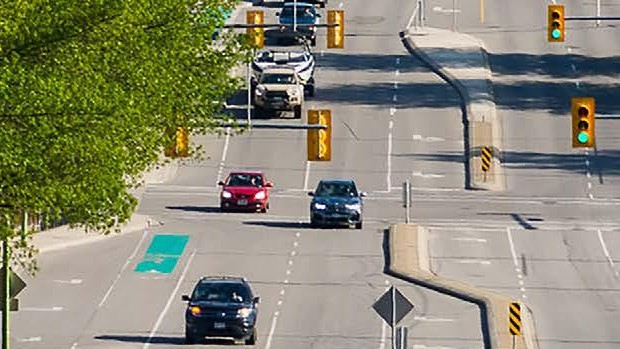
In 2024, Kelowna selected NoTraffic for a technical demonstration of its Mobility Platform across five intersections.
The deployment emphasized:
- Reducing peak and all-day delay
- Enhancing off-peak progression
- Maintaining pedestrian wait times below 60 seconds
NoTraffic Optimization was deployed using fusion video/radar sensors and adaptive policies that dynamically adjust cycle lengths, splits, and offsets based on real-time conditions.
Additional considerations for the deployment included:
- No changes to signal sequences or pedestrian recalls
- No modification to lane alignment or signal minimums
The Result
The NoTraffic Mobility Platform delivered strong results across five key intersections on Springfield Road, where 35,000 vehicles travel daily. Kelowna saw a 12% overall delay reduction, including 8% in the AM and 14% in the PM, with eastbound drivers saving 20–25 seconds per trip.
At Springfield & Dilworth / Benvoulin, delays dropped by 40%, and westbound left-turn delay in the PM, previously a major issue, decreased by 22%. Total travel time savings reached 39,000 hours annually. Adaptive signal timing improved efficiency for drivers without compromising pedestrian or side street performance.
Both internal data and third-party metrics confirmed the improvements. Overall results validated adaptive signal optimization as a scalable solution for growing mid-sized cities.
| Metric | Improvement (%) |
| Overall Delay | Reduced 12 % |
| Springfield & Dilworth/Benvoulin | Reduced 40 % |
| Pedestrian Delay | Kept to less than 60 sec |
| AM Peak Delay | Reduced 8 % |
| PM Peak Delay | Reduced 14 % |
| Total Economic Value * | $4.2 M ($5.8 M CAD) |
| CO2 Reduction ** | 1,600 mt |
| CO2 Reduction (tree-equivalents) ** | 15,000 |
A Model for Balancing Growth & Safety
Kelowna’s success in optimizing the Springfield Corridor demonstrates how data-driven mobility solutions empower mid-sized cities to manage rapid growth, support multimodal goals, and enhance safety. NoTraffic’s ability to dynamically balance pedestrian and vehicle needs resulted in measurable delay reductions and significant value creation for both residents and visitors, all without requiring infrastructure changes.
“If a particular intersection experiences a sudden increase in traffic, the adaptive system can quickly allocate more green time to alleviate congestion,” states manager Geert Bos to Kelowna city council. “If traffic volumes are suddenly reduced in one direction, the system can reallocate additional time to where it’s needed. This approach enhances overall traffic efficiency, reduces travel time, delay, and emissions, without compromising traffic safety.”
NOTES:
* Total Economic Value represents time and gas savings over the initial 5-year warranty plus operational savings related to signal re-timing, included data and analytics package, persistent camera installation, and NOC support
** Over initial 5-year warranty period







